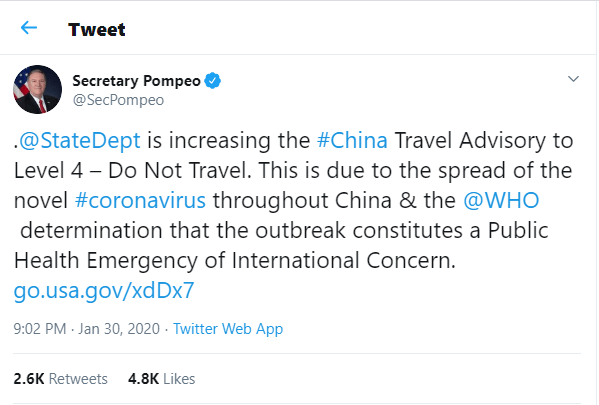Bird Flu: China’s Ticking Time Bomb of Infectious Disease

As China's ascendancy to world power continues, infectious diseases could become the norm. | Image: REUTERS / Bobby Yip / File Photo
- A highly pathogenic strain of bird flu, H5N1, has caused an outbreak in China’s Hunan province, near ground zero of the deadly coronavirus.
- The disease doesn’t easily infect humans but when it does, it carries a staggering mortality rate of 60% according to the WHO.
- China is a hotbed of emerging diseases. As the country rises to economic prominence, this puts the global economy at risk.
For most people who live in first world countries, infectious diseases are not a big concern. We get a cocktail of vaccines as children and go on to live relatively healthy lives. The biggest things we have to worry about are the common flu, the common cold, and occasionally, strep throat. As China rises to global prominence, in a world that has grown increasingly interconnected, things may be changing.
We could be reverting to a time when deadly diseases were a fact of life for everyone – in every country.
As the global coronavirus outbreak grows to infect over 20,000 with 425 fatalities, China finds itself in the cross hairs of a new, dangerous outbreak: bird flu, an infection that can kill poultry and humans alike. While the disease, known as H5N1, hasn’t infected any humans yet, it’s revealing a disturbing pattern with global implications. New diseases are emerging at an alarming rate, and this puts the whole world at risk.
The Coronavirus is Still at Large
According to the latest data, Wuhan coronavirus has grown to infect 20,680 people – the majority in Hubei province, China. The disease has spread to 27 countries and 427 people have died .
In response, U.S authorities have taken drastic actions to limit contact with China. The State Department has issued a travel warning, airlines are canceling flights and American companies with Chinese operations are shuttering operations in the country.

Authorities should have the ability to get the coronavirus under control but what will they do when the next massive outbreak crops up? Can the global economy withstand these repeated shocks?
Another Outbreak: Bird Flu
According to China’s Ministry of Agriculture and Rural Affairs, the nation is experiencing an outbreak of a highly pathogenic strain of bird flu called H5N1. The disease has already killed 4,500 chickens in Hunan province alone and the government has culled almost 18,000 chickens to prevent its spread.
According to the United States Geological Survey, there’s no need to panic about the term “highly pathogenic” because it refers to the virus’s ability to kill chickens, not humans.
The designation of low or highly pathogenic avian influenza refers to the potential for these viruses to kill chickens. The designation of “low pathogenic” or “highly pathogenic” does not refer to how infectious the viruses may be to humans, other mammals, or other species of birds.
The World Health Organization (WHO) paints a more disturbing picture of the disease.
Human cases of H5N1 avian influenza occur occasionally, but it is difficult to transmit the infection from person to person. When people do become infected, the mortality rate is about 60%.
They go on to elaborate
Influenza viruses constantly undergo genetic changes. It would be a cause for concern, should the H5N1 virus become more easily transmissible among humans.
A 60% mortality rate is staggering. To put this in perspective, note that coronavirus has a mortality rate of only 2.1% while SARS had a mortality rate of 9.6%. With a mortality rate of 60%, the bird flu is as deadly as Ebola . While it doesn’t currently spread well among humans, experts believe it can mutate into more virulent forms.
This is a ticking time bomb.